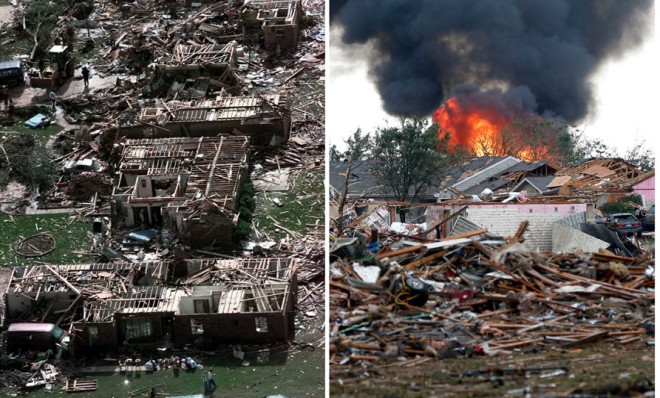Why Tornado Alley is prone to disaster
There are scientific reasons why Moore, Okla., has seen more than its share of massive, killer twisters


The deadly tornado that devastated Moore, Okla., on Monday traveled a track that was, at least briefly, eerily similar to the one followed by another deadly twister that tore through the town 14 years ago. That 1999 twister — part of a 74-tornado outbreak — pulverized entire neighborhoods with winds reaching 318 miles per hour — the strongest ever recorded on Earth.
Monday's two-mile-wide twister caused even greater destruction. Meteorologists say it's extremely rare for any town to get hit twice by killer tornadoes. Why does Moore have such terrible luck? A brief guide:
Why is this part of Oklahoma so vulnerable to killer tornadoes?
The Week
Escape your echo chamber. Get the facts behind the news, plus analysis from multiple perspectives.

Sign up for The Week's Free Newsletters
From our morning news briefing to a weekly Good News Newsletter, get the best of The Week delivered directly to your inbox.
From our morning news briefing to a weekly Good News Newsletter, get the best of The Week delivered directly to your inbox.
The short explanation is that Moore sits at the heart of Tornado Alley. Tornado Alley extends from the Rocky Mountains in the West to the Appalachians in the East. Seventy-five percent of the world's tornadoes hit in the U.S. That's more than 1,000 per year. (Canada, at No. 2, has just 100 per year.) And nowhere are they more common than in the swath of the nation's midsection centered around Texas, Oklahoma, Kansas, and the states to the north.
What makes tornadoes so common there?
The Rockies block moist air from flowing eastward. This clears the way for frigid Arctic air to stream south from Canada over the Great Plains. These cold blasts then run into warm, humid air coming up from the Gulf of Mexico. When these cold and warm air masses collide, they cause powerful rotating updrafts and downdrafts that can create dangerous thunderstorms known as "supercells," which in turn spawn powerful tornadoes.
Is that what happened this time?
A free daily email with the biggest news stories of the day – and the best features from TheWeek.com
Yes. Tornado season — which peaks in April — had been unusually weak this spring. There were only 72 tornadoes nationwide in April, which is 70 percent below the 10-year average. But in the last week, a cold front ran into warm air blowing north from the Gulf of Mexico. The cold air acted as a wedge, pushing up the less dense warm air, creating swirling gyres. Some flipped vertically into tornadoes. "It's kind of the perfect set-up," Jeff Weber, a scientist with the University Corporation for Atmospheric Research in Boulder, Colo., told LiveScience.
So people are familiar with the warning signs?
Yes, says Paul Whitefield — who grew up in Tornado Alley — at The Los Angeles Times. "When spring comes, you watch the sky, and you learn the signs," he says. "First, bad storms have a certain look: Ominous, dark clouds, often with an odd greenish tint, which can indicate hail. Then, a sudden temperature drop — it can be near 100 degrees and sweltering one minute, almost cold the next. And most chilling of all, a stillness that's like nothing else I've ever experienced: From strong winds whipping the trees to a clammy calm in seconds. If you weren’t afraid before, you are then."
If this happens frequently, why aren't there more safe shelters?
After the 1999 twister, people in and around Moore built storm shelters and 6,000 safe rooms, which are concrete bunkers built to withstand winds over 250 miles per hour. FEMA offered Oklahomans loans to rebuild homes so they'd be strong enough to stand up to the next tornado. It's too early to say whether the attempts to bolster the town's defenses paid off, though, as the search for survivors and bodies is still underway, and authorities haven't begun to assess the scope of the property damage.
Is any place in the U.S. as vulnerable as Tornado Alley?
Several studies actually suggest that the heart of Tornado Alley where Moore sits isn't even the deadliest area. A swath of the lower Mississippi Valley known as Dixie Alley has the most tornado-related deaths. That's due to a combination of factors. This area, too, is prone to violent thunderstorms. But in the Southeast, the storms are more likely to hit at night, so people in a twister's path often don't know danger is in the air. And the region is full of large trees, which tornadoes can rip from the ground and hurl onto buildings and cars. The region also has many manufactured homes that can't hold up to high winds and have no basements where occupants can seek shelter.
Sources: The Atlantic, The Daily Beast, NBC News (2), Telegraph, The Washington Post
Harold Maass is a contributing editor at The Week. He has been writing for The Week since the 2001 debut of the U.S. print edition and served as editor of TheWeek.com when it launched in 2008. Harold started his career as a newspaper reporter in South Florida and Haiti. He has previously worked for a variety of news outlets, including The Miami Herald, ABC News and Fox News, and for several years wrote a daily roundup of financial news for The Week and Yahoo Finance.



